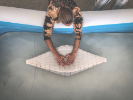Tectonics of Buoyancy

The relationship between the water and the city, between water and people, and between water and architecture, is a critically important issue. In the BuffaloNiagara Region, it is now understood that the typical strategy of fortifying against the elements and creating barricades along the water has had catastrophic ecological, social, and cultural impacts. The junior’s semester-long investigation explored and reflected on the role of water in human settlement and new tectonic possibilities for living in and along the water’s edge.
Gallery
Students
Samantha Kalinski
Damian Majkrzak
Paul Odell
Zakaria Siddiqui
Taylor Stewart (Cocoon), Samantha Kalinski
Damian Majkrzak (Agglo),
Isabelle Dabrowski
Marietta Koeberle
Brianna Mancini
Benjamin Wemesfelder (B.V. Gallagher),
Leo McDowell Chmelar
Benjamin Wemesfelder (Enviro-Movement)
Faculty
Randy Fernando
Emily Kutil
Term
ARC 301
Fall 2019
Program
BS Arch
The relationship between the water and the city, between water and people, and between water and architecture, is a critically important issue. In the BuffaloNiagara Region, it is now understood that the typical strategy of fortifying against the elements and creating barricades along the water has had catastrophic ecological, social, and cultural impacts. The junior’s semester-long investigation explored and reflected on the role of water in human settlement and new tectonic possibilities for living in and along the water’s edge.
The studio began with the design and construction of buoyant vessels. These became points of investigation for fundamental questions pertaining to architectural tectonics, such as space and geometry, structure and skin, form and function, and material and construction.
Each studio had to produce three boats, each designed to complete a different task at the culminating regatta at Gallagher Beach. The first heat tested speed and had the skippers race the length of the beach. The paddle was then passed off to the next skipper, who had to maneuver between piers. The third heat required the skipper to paddle out to a buoy, retrieve a 60-pound drybag, lift it into the vessel, and return to shore. The first studio to complete all three tasks won the Keelson Award.
To further the pedagogical investigation into tectonics, and to understand the relationship between water and the built environment, students were tasked with designing a River-Station to reintegrate people and water. The experimental proposals were required to “float” within Buffalo’s outer harbor.
Cocoon
This vessel utilizes kinetic fabric to be hyper-responsive to the human body. As weight and force are applied, the fabric skin goes through two main phase changes. When the fabric is relaxed and neutral, it is in its passive stage. When external forces are applied, causing the fabric to stretch and elongate, it is in its active stage
The kinetic skin allows the user to find equilibrium by stabilizing the body while the surface area displaces water beneath to steady the vessel. The fabric is coated in fiber glass resin to create a waterproof membrane. The combination of these elements allow the user to create an intimate relationship with the vessel.
Agglo
Majkrzak and Kalinski carried over the structural logic of Cocoon into the design of Agglo. The masts, cables, buoys, anchor points, and skin act as one tensile system. This flexibility allows for the structure and form to be physically responsive to natural forces. The skin will flex and transform spatially in response to seasonal changes and forces applied by water currents.
Majkrzak and Kalinski’s conceptual development and programmatic organization were informed by a biological understanding of seaweed clusters. This translated into the design of a series of tubes based on the logic of the clusters. The largest tubes were structural, allowing the masts to pass through the space. They also allowed light to enter into the space and filter down to the water, becoming a site of photosynthetic activity for the seaweed and a space for observing growth and marine life.
B.V. Gallagher
This vessel was designed to compete in the third heat, so the structure also had to be capable of picking up sand bags from the water and placing them inside. This meant that the boat had to be properly sealed and able to lean on one side without taking in any water.
The team’s process started with a flat bottom boat that had arms that curved out. The main idea behind this was that a flat bottom would disperse the most amount of water and the space underneath the arms would act like a suction cup once the structure edge met the water level. During the testing process, the flat bottom made it difficult to move forward when rowing, so a keel was added to help steer.
The structure was built first, and then canvas and coats of exterior latex paint were layered on top for waterproofing. It won the Seaworthiness Award along with the Keelson Award for the overall studio.
Enviro-Movement
Wesemfelder and McDowell-Chmelar’s Enviro-Movement consisted of five separate bulbs. They were designed to respond to the forces of nature and the movement of the lake. With everchanging conditions on Lake Erie, such as the rise and fall of water levels, wave action, and weather, the system of bulbs utilize an expressive and flexible structural concept
The bulbs can individually fluctuate vertically up to 14 feet, depending on the applied forces, minimizing the overall movement felt by occupants. This is achieved through the design of kinetic rails that connect the main structures to their foundations, allowing for flexibility in the Z axis. Barge-like chambers sit on top of the rails and act as bases to the interior space within the bulbs, creating buoyancy.
The foundation, structure, and skin ultimately work together as one system to both dampen and display environmental motion.




